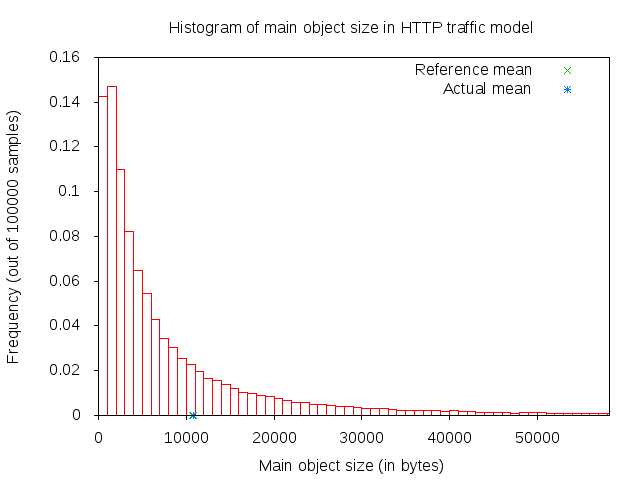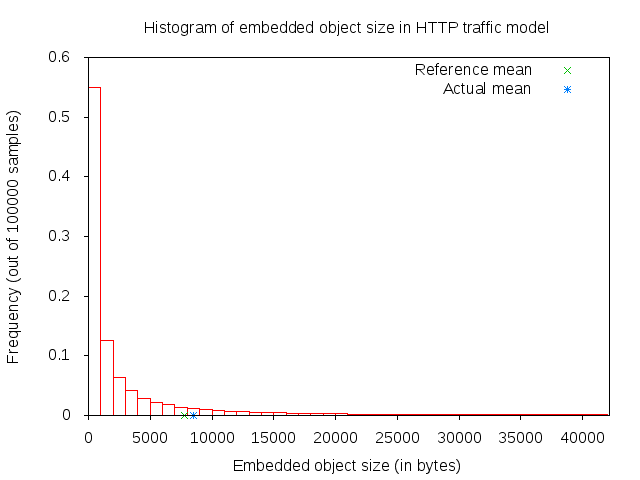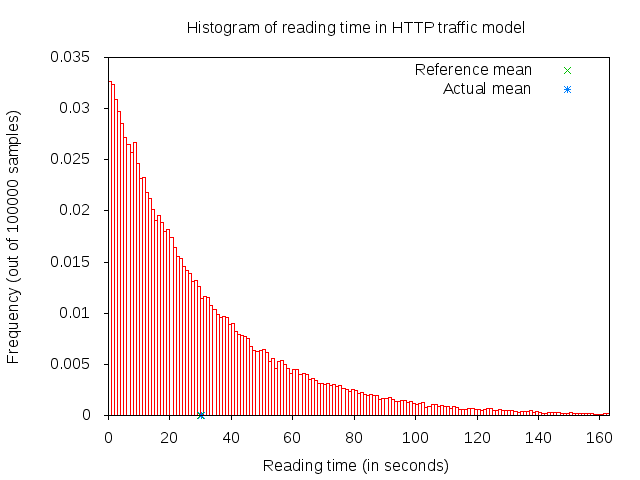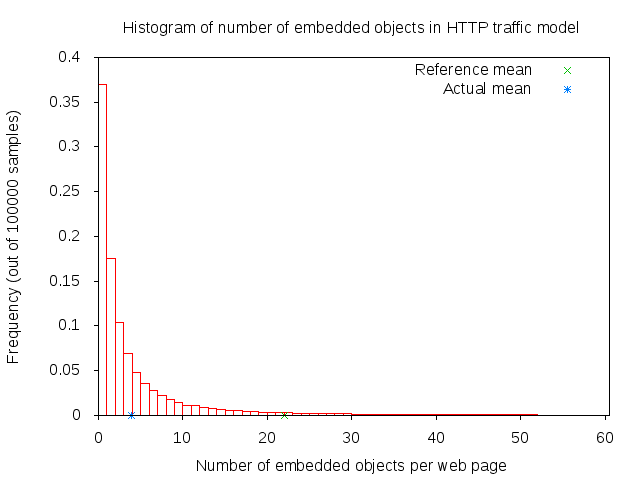3GPP HTTP applications¶
Model Description¶
The model is a part of the applications library. The HTTP model is based on a commonly used 3GPP model in standardization [4].
Design¶
This traffic generator simulates web browsing traffic using the Hypertext
Transfer Protocol (HTTP). It consists of one or more ThreeGppHttpClient
applications which connect to a ThreeGppHttpServer application. The client
models a web browser which requests web pages to the server. The server
is then responsible to serve the web pages as requested. Please refer to
ThreeGppHttpClientHelper and ThreeGppHttpServerHelper for usage instructions.
Technically speaking, the client transmits request objects to demand a service from the server. Depending on the type of request received, the server transmits either:
a main object, i.e., the HTML file of the web page; or
an embedded object, e.g., an image referenced by the HTML file.
The main and embedded object sizes are illustrated in figures 3GPP HTTP main object size histogram and 3GPP HTTP embedded object size histogram.

3GPP HTTP main object size histogram¶

3GPP HTTP embedded object size histogram¶
A major portion of the traffic pattern is reading time, which does not generate any traffic. Because of this, one may need to simulate a good number of clients and/or sufficiently long simulation duration in order to generate any significant traffic in the system. Reading time is illustrated in 3GPP HTTP reading time histogram.

3GPP HTTP reading time histogram¶
3GPP HTTP server description¶
3GPP HTTP server is a model application which simulates the traffic of a web server. This
application works in conjunction with ThreeGppHttpClient applications.
The application works by responding to requests. Each request is a small
packet of data which contains ThreeGppHttpHeader. The value of the content type
field of the header determines the type of object that the client is
requesting. The possible type is either a main object or an embedded object.
The application is responsible to generate the right type of object and send
it back to the client. The size of each object to be sent is randomly
determined (see ThreeGppHttpVariables). Each object may be sent as multiple packets
due to limited socket buffer space.
To assist with the transmission, the application maintains several instances
of ThreeGppHttpServerTxBuffer. Each instance keeps track of the object type to be
served and the number of bytes left to be sent.
The application accepts connection request from clients. Every connection is kept open until the client disconnects.
Maximum transmission unit (MTU) size is configurable in ThreeGppHttpServer or in
ThreeGppHttpVariables. By default, the low variant is 536 bytes and high variant is 1460 bytes.
The default values are set with the intention of having a TCP header (size of which is 40 bytes) added
in the packet in such way that lower layers can avoid splitting packets. The change of MTU sizes
affects all TCP sockets after the server application has started. It is mainly visible in sizes of
packets received by ThreeGppHttpClient applications.
3GPP HTTP client description¶
3GPP HTTP client is a model application which simulates the traffic of a web browser. This application works in conjunction with an ThreeGppHttpServer application.
In summary, the application works as follows.
Upon start, it opens a connection to the destination web server (ThreeGppHttpServer).
After the connection is established, the application immediately requests a main object from the server by sending a request packet.
After receiving a main object (which can take some time if it consists of several packets), the application “parses” the main object. Parsing time is illustrated in figure 3GPP HTTP parsing time histogram.
The parsing takes a short time (randomly determined) to determine the number of embedded objects (also randomly determined) in the web page. Number of embedded object is illustrated in 3GPP HTTP number of embedded objects histogram.
- If at least one embedded object is determined, the application requests
the first embedded object from the server. The request for the next embedded object follows after the previous embedded object has been completely received.
- If there is no more embedded object to request, the application enters
the reading time.
Reading time is a long delay (again, randomly determined) where the application does not induce any network traffic, thus simulating the user reading the downloaded web page.
After the reading time is finished, the process repeats to step #2.

3GPP HTTP parsing time histogram¶

3GPP HTTP number of embedded objects histogram¶
The client models HTTP persistent connection, i.e., HTTP 1.1, where the connection to the server is maintained and used for transmitting and receiving all objects.
Each request by default has a constant size of 350 bytes. A ThreeGppHttpHeader
is attached to each request packet. The header contains information
such as the content type requested (either main object or embedded object)
and the timestamp when the packet is transmitted (which will be used to
compute the delay and RTT of the packet).
References¶
Many aspects of the traffic are randomly determined by ThreeGppHttpVariables.
A separate instance of this object is used by the HTTP server and client applications.
These characteristics are based on a legacy 3GPP specification. The description
can be found in the following references:
[1] 3GPP TR 25.892, “Feasibility Study for Orthogonal Frequency Division Multiplexing (OFDM) for UTRAN enhancement”
[2] IEEE 802.16m, “Evaluation Methodology Document (EMD)”, IEEE 802.16m-08/004r5, July 2008.
[3] NGMN Alliance, “NGMN Radio Access Performance Evaluation Methodology”, v1.0, January 2008.
[4] 3GPP2-TSGC5, “HTTP, FTP and TCP models for 1xEV-DV simulations”, 2001.
Usage¶
The three-gpp-http-example can be referenced to see basic usage of the HTTP applications.
In summary, using the ThreeGppHttpServerHelper and ThreeGppHttpClientHelper allow the
user to easily install ThreeGppHttpServer and ThreeGppHttpClient applications to nodes.
The helper objects can be used to configure attribute values for the client
and server objects, but not for the ThreeGppHttpVariables object. Configuration of variables
is done by modifying attributes of ThreeGppHttpVariables, which should be done prior to helpers
installing applications to nodes.
The client and server provide a number of ns-3 trace sources such as “Tx”, “Rx”, “RxDelay”, and “StateTransition” on the server side, and a large number on the client side (“ConnectionEstablished”, “ConnectionClosed”,”TxMainObjectRequest”, “TxEmbeddedObjectRequest”, “RxMainObjectPacket”, “RxMainObject”, “RxEmbeddedObjectPacket”, “RxEmbeddedObject”, “Rx”, “RxDelay”, “RxRtt”, “StateTransition”).
Building the 3GPP HTTP applications¶
Building the applications does not require any special steps to be taken. It suffices to enable the applications module.
Examples¶
For an example demonstrating HTTP applications run:
$ ./ns3 run 'three-gpp-http-example'
By default, the example will print out the web page requests of the client and responses of the
server and client receiving content packets by using LOG_INFO of ThreeGppHttpServer and ThreeGppHttpClient.
Tests¶
For testing HTTP applications, three-gpp-http-client-server-test is provided. Run:
$ ./test.py -s three-gpp-http-client-server-test
The test consists of simple Internet nodes having HTTP server and client applications installed. Multiple variant scenarios are tested: delay is 3ms, 30ms or 300ms, bit error rate 0 or 5.0*10^(-6), MTU size 536 or 1460 bytes and either IPV4 or IPV6 is used. A simulation with each combination of these parameters is run multiple times to verify functionality with different random variables.
Test cases themselves are rather simple: test verifies that HTTP object packet bytes sent match
total bytes received by the client, and that ThreeGppHttpHeader matches the expected packet.
